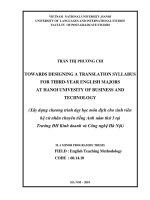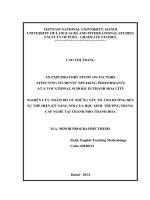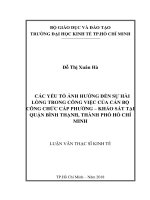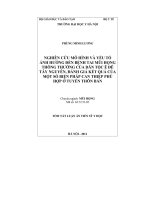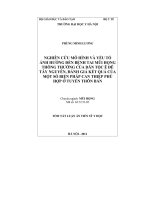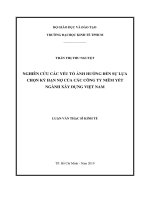Nghiên cứu thăm dò những yếu tố ảnh hưởng đến sự thể hiện kỹ năng nói của học sinh trường trung cấp nghề ở thành phố Thanh Hóa
Bạn đang xem bản rút gọn của tài liệu. Xem và tải ngay bản đầy đủ của tài liệu tại đây (558.7 KB, 68 trang )
VIETNAM NATIONAL UNIVERSITY, HANOI
UNIVERSITY OF LANGUAGES AND INTERNATIONAL STUDIES
FACULTY OF POST - GRADUATE STUDIES
*****************************
CAO THỊ TRANG
AN EXPLORATORY STUDY ON FACTORS
AFFECTING STUDENTS’ SPEAKING PERFORMANCE
AT A VOCATIONAL SCHOOL IN THANH HOA CITY
NGHIÊN CỨU THĂM DÒ VỀ NHỮNG YẾU TỐ ẢNH HƯỞNG ĐẾN
SỰ THỂ HIỆN KỸ NĂNG NÓI CỦA HỌC SINH TRƯỜNG TRUNG
CẤP NGHỀ TẠI THÀNH PHỐ THANH HÓA
M.A. MINOR PROGRAMME THESIS
Field: English Teaching Methodology
Code: 60140111
Hanoi– 2014
VIETNAM NATIONAL UNIVERSITY, HANOI
UNIVERSITY OF LANGUAGES AND INTERNATIONAL STUDIES
FACULTY OF POST - GRADUATE STUDIES
************************
CAO THỊ TRANG
AN EXPLORATORY STUDY ON FACTORS
AFFECTING STUDENTS’ SPEAKING PERFORMANCE
AT A VOCATIONAL SCHOOL IN THANH HOA CITY
NGHIÊN CỨU THĂM DÒ VỀ NHỮNG YẾU TỐ ẢNH HƯỞNG ĐẾN
SỰ THỂ HIỆN KỸ NĂNG NÓI CỦA HỌC SINH TRƯỜNG TRUNG
CẤP NGHỀ TẠI THÀNH PHỐ THANH HÓA
M.A. MINOR PROGRAMME THESIS
Field: English Teaching Methodology
Code: 60140111
Supervisor: Nguyễn Thị Ngọc Quỳnh Ph.D
Hà Nội– 2014
i
DECLARATION
I certify that this thesis entitled “An exploratory study on factors
affecting students’ speaking performance at a vocational school in Thanh
Hoa city” is entirely my own work. I have provided fully documented
references to the work of others. The material in this thesis has not been
submitted for assessment in any other formal course of study.
Hanoi, September 2014
Signature
Cao Thị Trang
ii
ACKNOWLEDGEMENTS
Firstly, I would like to express my faithful gratitude to my supervisor,
Dr. Nguyễn Thị Ngọc Quỳnh for her patient guidance, stimulating
suggestions and encouragement throughout my research.
I also wish to thank all the staff members of the faculty of Post
Graduate Studies, University of Language and International studies, VNU for
providing me the best environment to fulfill my course and my thesis.
Especially I am really indebted to my colleagues and my students at
VSTH for their active participation and assistance without them my reseach
would not exist.
Last but not least, I would like to express my special thanks to my
loving parents, my husband and my daughters who are always with me to
encourage and readily support me on any sitiuations so that I could
accomplish my study.
Hanoi, September 2014
iii
ABTRACT
The current study was carried out to investigate factors affecting college
students’ performance. The focus of this research was to investigate the
factors affecting students’ performance in English speaking class room with
the first - year students at a vocational school in Thanh Hoa city. To achieve
these aims, both quantitative and qualitative research approaches were
employed. The data was collected via a number of instruments including:
questionnaires for students and teachers. In this study, 116 first-year students
from different faculties were chosen randomly as the participants. The major
findings of the research showed that the factors affecting students’ speaking
performance in English speaking classroom fall into of three categories:
students’ factors, teachers’ factors, classroom factors. The study also
demonstrated that among three main factors, the students’ factors were proved
to be the most affected whereas teachers’ factors were ranked as second.
Based on the findings of the study, some discussion and implications were
made along with recommended suggestion for further research.
iv
LIST OF ABBREVIATIONS
VSTH: The vocational school in Thanh Hoa city
CLT: Communicative Language Teaching
EFL: English as Foreign Language
v
LIST OF FIGURES AND TABLES
Figure 1 21
Figure 2 24
Figure 3 25
Figure 4 27
Figure 5 31
Figure 6 31
Figure 7 32
Figure 8 33
Figure 9 34
Figure 10 36
Table 1 20
Table 2 21
Table 3 22
Table 4 25
Table 5 26
Table 6 28
Table 7 29
Table 8 30
Table 9 33
Table 10 35
Table 11 37
Table 12 38
Table 13 39
vi
TABLE OF CONTENTS
DECLARATION i
ACKNOWLEDGEMENTS ii
ABSTRACT iii
TABLE OF CONTENTS iv
LIST OF ABBREVIATIONS vii
LIST OF FIGURES AND TABLES viii
PART A: INTRODUCTION 1
1. Rationale 1
2. Aims of the study 2
3. Research question 2
4. Methods of the study 3
5. Significance of the study 3
6. Scope of the study 3
7. Organization of the study 3
PART B: DEVELOPMENT 5
CHAPTER 1: LITERATURE REVIEW 5
1.1. Speaking in foreign language learning and teaching 5
1.1.1. Definitions of speaking 5
1.1.2. Importance of speaking 6
1.1.3. Approaches to the teaching of speaking 7
1.1.4. Types of classroom speaking performance 8
1.2. Factors affecting students’ speaking performance 9
1.2.1. Students’ factors 9
1.2.1.1. Students’ motivation 9
1.2.1.2. Students’ language levels 10
vii
1.2.1.3. Students’ personality and anxiety 12
1.2.1.4. Family background 13
1.2.2. Teachers’ factors 13
1.2.2.1. Teacher’s role 13
1.2.2.2. Teacher’s knowledge and characteristics 13
1.2.2.3. Teacher’s method 14
1.2.3. Classroom factors 15
1.2.3.1. Classroom atmosphere 15
1.2.3.2. Class size . 15
1.2.3.3. Classroom physical condition 16
CHAPTER 2: METHODOLOGY 17
2.1. Research setting 17
2.1.1. An overview of The Vocational school in Thanh Hoa city 17
2.1.2. The teachers 17
2.1.3. The students 17
2.1.4. The materials and syllabus 17
2.2. The participants 18
2.3. Data collections instruments 18
2.4. Data collection procedures 19
2.5. Data analysis procedures 19
CHAPTER 3: DATA ANALYSIS 20
3.1. Data analysis of survey questionnaire for students 20
3.2. Data analysis of survey questionnaire for teachers 31
CHAPTER 4: MAJOR FINDINGS, DISSCUSSION AND
IMPLICATIONS 40
4.1. Major findings and discussion 40
4.1.1. The students 40
viii
4.1.2. The teachers 40
4.1.3. The classroom 41
4.2. Implications 42
PART C: CONCLUSION 45
1. Conclusion 45
2. Limitations and suggestion for further study 45
REFERENCES 47
APPENDICES I
APPENDIX 1: QUESTIONNAIRE FOR STUDENTS I
APPENDIX 2: QUESTIONNAIRE FOR TEACHERS V
1
PART A: INTRODUCTION
1. Rationale
Undeniably, English is the most important international language and
becoming an indispensable means of communication with the rest of the
world. It provides ready access to the world scholarship and world trade.
Thus, the demand of learning English is becoming more urgent than ever. In
Viet Nam, it is a compulsory subject at all levels of learners. In learning
English, the fours skills namely reading, writing, speaking, listening are very
important but speaking seems to be the most significant. All learners of
English want to achieve this skill. All teachers pay much attention on
speaking for their students.
However, the teaching and learning of English speaking in Viet Nam have
encountered many difficulties. In fact, although most of Vietnamese learners
can be good at grammar, reading and writing skill, few of them can speak
English correctly and fluently. It takes learners lots of time if they want to be
professional at it. Since, the learners are often reluctant in speaking English.
There have been variety of solutions given such as changing teaching method,
changing textbooks, upgrading teachers’ qualification and so on, the poor
performance of students in speaking remains a common problem in acquiring
the language.
As a teacher of a vocational school in Thanh Hoa city the researcher see that
most of her students facing these problems. They do not often enjoy speaking
English and they do not actively contribute to the speaking lessons. They feel
hardly to express their thought in English and the safe way they choose is
keeping quiet. With their poor performance in speaking English, they lost
their opportunities to get the good jobs of the competitive labor market.
All the above mentioned reasons have inspired the writer to conduct a
2
research entitled “An exploratory study on factors affecting students’
speaking performance at a vocational school in Thanh Hoa city”.
2. Aims of the study
The study is carried out to find out some factors affecting students’ speaking
performance at a vocational school in Thanh Hoa city.
3. Research questions
In order to achieve the above-mentioned objective, the study was
implemented to answer the question: What are the factors affecting students’
speaking performance at the vocational school in Thanh Hoa city?
4. Methods of the study
To conduct the study, several methods were used, but the researcher
used mainly quantitative and qualitative methods. The data collected for the
study will come from two sources: the student respondents and the English
teacher respondents at the vocational school in Thanh Hoa city.
Two sets of questionnaires, one for students and the other for teachers,
are going to be used as data collection instruments. All the comments,
recommendations and conclusions provided in the study will be based on the
data analysis.
5. Significance of the study
The study may be helpful for both students and teachers of English. It may
help the English teachers to implement suitable teaching method to their
students. Teachers can use the outcomes of the study as a reference in their
research when they want to conduct the study related to teaching and learning
speaking in general and factors affecting students’ speaking performance in
particular. It may also create awareness among students about their problems
in learning English to achieve more effective education.
6. Scope of the study
3
Studying English speaking performance as a foreign language has been paid
attention by many researchers so far. However, due to the limit of time and
capacity, within the scope of an M.A. minor thesis, the researcher only
focuses on factors affecting students’ speaking performance including
students’ motivation, students’ language level, students’ personality and
anxiety and family background, teachers’ role, teachers’ knowledge and
characteristics, teachers’ teaching methods, classroom atmosphere, class size,
classroom physical condition. The subjects of the study are 5 English teachers
and 116 students from the Vocational school in Thanh Hoa city.
7. Organization of the study
The study is divided into three parts: the Introduction, the Development and
the Conclusion.
PART A: INTRODUCTION - deals with the rationale, aims, research
questions, methods, scope, and organization of the study.
PART B: DEVELOPMENT including the following chapters:
CHAPTER 1: Literature review, presents the theoretical background of
speaking in which definition of speaking, the role of speaking in foreign
language teaching, approaches of teaching speaking; issues of students’
speaking performance including types of speaking performance and factors
affecting students’ speaking performance.
CHAPTER 2: Methodology gives overview of the research site, the
participants, data collections instruments, data collection procedures and data
analysis procedures.
CHAPTER 3: Data analysis provides the analysis of the survey
questionnaire for students and the analysis of the survey questionnaire for
teachers.
CHAPTER 4: Major findings, discussion and implications give some major
4
finding, suggestion and implications to improve students’ speaking
performance.
PART C: CONCLUSION - summarizes all the key issues of the study as
well as the limitations and suggestion for further study
5
PART B: DEVELOPMENT
CHAPTER 1: LITERATURE REVIEW
1.1. Speaking in foreign language learning and teaching
1.1.1. Definitions of speaking
Florez (1991:1) defines speaking as “an interactive process of constructing
meaning that involves producing and receiving and processing information”
(cited in Bailey, 2005:2). It is “often spontaneous, open-ended and evolving”,
but it is not completely unpredictable.
In addition, speaking is “the process of building and sharing meaning through
the use of verbal and non verbal symbols, in a variety contexts” (Chaney,
1998:13). Bailey (2005:2) shares the same view that “speaking is the
productive, oral skill. It consists of producing systematic verbal utterances to
convey meaning.” As Jones, (1989: 86) defines, “speaking is a form of
communication, so it is important that what you say conveyed in the most
effective way.”
According to Mackey (1965) “ oral expression involves not only the use of
the right sounds in the right patterns of rhythm and intonation, but also a
choice of words and inflections in the right order to convey the right
meaning”, (cited in Bygate, 1987:5)
In study of Brown and Yule (1983), spoken language consists of short,
fragmentary utterances, in a range of pronunciation. They also point out that
spoken language is made to feel less conceptually dense than other types of
language.
From some definitions above it can be concluded that speaking skill is always
related to communication. Speaking skill itself can be stated as the
productive, oral skill, using the language accurately to express meanings in
order to transfer or to get knowledge and information from other people in the
6
whole life situation.
1.1.2. Importance of speaking
Speaking plays an utmost important role among the four language skills since
it is the fundamental to human communication (Ur 1996:120). It can not be
denied that in our daily lives, people spend more time on speaking rather than
on writing. According to Hymes (1972) “The goal of language teaching is to
develop communicative competence. Pattison (1992) confirms that when
people know or learn a language, they mean being able to speak the language.
More than this, Ur (1996) shows that people who knows a language are
referred to as “speaker” of that language as if speaking included all other
kinds of knowing. The mastery of speaking skills in English is a priority for
many second-language or foreign-language learners (Jack C. Richards
2008:19)
Moreover, oral English can be very useful for development of reading and
writing skills. Rivers (1968) points out: “when we read and write, we call
upon what we know of the language orally”. (p.20) He goes on to say that
there must be a connection between reading and speaking. If the students are
reading, and then they are using their oral English, too. If a student has poor
English, his reading ability may also be poor. Similarly, Rivers (1968) argues
that writing involves oral ability as well.
In social contexts, speaking is particularly useful as it is key to
communication.
Kayi (2006) and Bygate (1987) share the same view that the learners need to
have ability to speak confidently to carry their most basic transactions.
In general, because of the importance of oral skill in language teaching and
learning, speaking skill should be paid more attention to.
1.1.3. Approaches in teaching speaking
7
In the history of language learning and teaching methods there have been
existed several approaches such as Grammar - Translation Method, Reading
Method, Audiolingualism, and Affective - Humanistic Approach and, etc.
However, CLT is the latest influence on teaching methodology which has
been put forth around the world as a new or innovative approach to teach
English as a second or foreign language. Therefore, in this section, the
researcher only discusses on CLT as an approach for teaching speaking skill.
To define CLT, Nunan (1989:194) states:
“CLT views language as a system for the expression of meaning. Activities
involve oral communication, carrying out meaning tasks and using language,
which is meaningful to the learners. Objectives reflect the needs of the
learners including functional skills as well as linguistics objectives. The
learner’s role is a negotiator and integrator. The teacher’s role is a
facilitator of the communication progress.”
In brief, CLT emphasizes communication in a foreign language and improves
the learners’ competence through communicative activities.
* Characteristics of CLT
According to Richards and Rogers (2001:161), CLT has a rich theoretical
base and some of the characteristics of the communicative view of language
are:
- Language is a system for the expression of meaning
- The primary function of language is to allow interaction and communication
- The structure of language reflects its functional and communicative use
- The primary units of language are not merely its grammatical and structural
features but categories of functional and communicative meaning as
exemplified in discourse.
In brief, CLT is characterized with communicative competence, leaner’s –
8
centeredness and four skills integration. These characteristics will be the
principles for teachers to choose appropriate techniques as well as activities in
the classroom to improve students’ communicative competence.
1.1.4. Types of classroom speaking performance
According to Brown (2000), there are six types of classroom speaking
performance (p.271) :
Imitative: This types of speaking performance is the ability to practice an
intonation and focusing on some particular elements of language form. In
fact, it’s simply imitaion of a word or phrase or possibly a sentence. The
important thing here is focusing on pronunciation. Drilling is used in teaching
and learning process to help students get opportunity to listen and orally
repeat some words.
Intensive: This is the students’ speaking performance that is practicing some
phonological and grammatical aspects of language. It relates to
the production of short stretches of oral language designed to
demonstrate competence in a narrow band of grammatical, phrasal, lexical, or
phonological relationships. It usually places students doing the task in pairs
(group work), for example, reading aloud that includes reading paragraph,
reading dialogue with partner in turn, reading information from chart, etc.
Responsive: Responsive performance includes interaction and test
comprehension but at the somewhat limited level of very short conversation,
standard greeting and small talk, simple request and comments.
Transactional: It is an extended form of responsive which has the purpose of
exchanging specific information, language. Conversations, for example, may
have more of a negotiate nature to them than does responsive speech.
Interpersonal (dialogue): Conversation is carried out more for the purpose of
maintaining social relationships than for the transmission of facts and
9
information. The forms of interpersonal speaking performance are interview,
role play, discussions, conversations and games
Extensive: Oral production task include speeches, oral presentations, and story-
telling. Language style is frequently more deliberative (planning is involved)
and formal for extensive tasks, but we cannot rule out certain informal
monologues such as casually delivered speech.
In brief, students need to know at least the pronunciation, vocabularies,
and language functions that they are going to use. When students are ready
and prepared for the activity, they can use the language appropriately
1.2. Factors affecting students’ speaking performance
A number of studies have been carried out to identify and analyze the
numerous factors that affect students’ speaking performance. Their findings
identify students’ effort, previous schooling parents’ education, family
income, self motivation, age of students, and entry qualifications as factors
that have a significant effect on the students’ performance in various settings.
Since not all factors are relevant for a particular context. The choice of factors
reviewed here was based on their importance to the current study.
1.2.1 Students’ factors
1.2.1.1. Students’ motivation
Lower motivation levels or lack of motivation is another reason for hindering
the students from active participation in speaking activities. It leads to
reluctance in active participation in the speaking activities leading to poor
performance or no performance at all.
According to Lightbown and Spada “motivation in second language learning
is a complex phenomenon which can be defined in terms of two factors:
learners’communicative needs and their attitudes towards the second language
community”. In other words, motivation in the present context refers to the
10
combination of effort plus desire to achieve the goal of learning the language
plus favorable attitudes towards learning the language (Garder, 1985; 10). He
also considered motivation as “a key consideration in determining the
preparedness of learners to communicate” and indicates that motivation of
foreign language learning contains four aspects: a goal, effortful behavior, a
desire to attain the goal and the attitude. It can be understood that if students
have strong learning motivation take positive attitude towards study and make
great efforts to master English with clear goal and desire, they will gain better
grade than those who have not acquired motivation.
Besides, Lightbown and Spada (1999:57) also points out some conditions that
help increase students’ motivation. They says that if we can make the
classroom places where students enjoy coming because of interesting content,
challenging but manageable and clear goals, supportive and non-threatening
atmosphere, we can make a positive contribution to students’ motivation.
It is true that motivation plays an important part in the success of second
language learning. The degree of motivation directly affects to the level of
involvement in speaking activities. The more motivated students are, the more
actively they are involved in speaking lessons.
1.2.1.2. Students’ language levels
Students’ language levels can be viewed as students’ linguistic competence or
students’ language proficiency which consists of the learners’ knowledge of
target language (Rod, 1985). The common problems in a Vietnamese
vocational school leading to low students’ language proficiency or students’
language proficiency in different levels are:
Lack of subject matter:
The common problem seen among students is that they think that they have
nothing to say on a particular topic because they are lack of social and cultural
11
knowledge. In reality, with limited knowledge they may be bored or feel that
the topic is unrelated to
anything they know . If this is the case, they can not confidently speak out
much about anything other than the fact that they should be participating in it
actively.
Lack of proper vocabulary:
Another problem encountered with learners is that they often feel anxious
when they have to search for what are appropriate to fit into the
context/content. This is because of lack of exposure to a variety of
vocabulary, structures or expressions. This also leads to failing in
communicating fluently in English, which again make students unwilling to
speak. Therefore, in the classroom many students just sit in silence and do not
participate in the classroom activities.
Moreover, in Burns and Joyce’s view, students have difficulties in
pronunciation such as sounds, rhythms and stress patterns of English, low
proficiency of grammar patterns and problems in transferring from the native
language into the target language.
Improper listening skills:
In the initial stages of language learning, beginning with listening activities
and following with speaking activities seems to be the most appropriate
sequence. Listening plays an extremely important role in the development of
speaking abilities. Usually, one person speaks and the other responds through
attending by means of the listening process. In fact, during interaction, every
speaker plays a duel role- both as a listener and a speaker. If one cannot
understand what is said, one is certainly unable to respond. So, speaking is
closely interwoven with listening skills.
All of these linguistics factors result in break – down in processing language
12
and communication.
1.2.1.3. Personality and anxiety
Personality
According to Brown (2000), personality is one of the affective factors that are
equally important for explaining different success among foreign language
learners. Personality can be divided into extroversion and introversion. While
extroversion is associated with risk-talking, introversion is subsumed under
the concept of self-esteem. Lightbown and Spada (1999:56) discussed a
number of personality characteristics that have a great influence on the
success of foreign language learners: extroversion, inhibition, self- esteem,
empathy, dominance, talkativeness and responsiveness. Moreover, he also
emphasize that it’s not the personality alone which dominate the outcome of
foreign language learning.
Students’ anxiety
Spielberger (1983:1) defines anxiety as “the subjective feeling of tension,
apprehension, nervousness, and worry associated with an arousal of the
automatic nervous system” (as cited in Brown (2007:161). It is associated
with feelings of uneasiness, frustration, self doubt, apprehension or worry
(Scovel, 1978:134). Through the research of Horwitz, Horwitz and Cope
(1986), they found out three main causes of language anxiety: communication
apprehension, text anxiety and fear of negative evaluation.
Anxiety and speaking performance are closely related. If the students fear of
losing face as making mistakes or being laughed at by other students, they
will certainlee keep quiet and wait until they and a general sense of failure in
the learners. Tsui (1996) reconfirmed are required to speak in oral English
lessons. Sometimes, extreme anxiety results in the students’ being tongue-tied
or lost for words in an unexpected situation leading to discouragement that
13
students’ fear of making mistakes and derision was one of the causes of
reluctance in speaking lessons.
1.2.1.4. Family background:
Many previous researches studied impacts of family background and rural
background on students’ academic performance including speaking
performance. They cited that parents’ personal background, parents’ income,
parents’ education and their location play an important role in their children’s
schooling achievements. In deed, if a student is lucky lived in a family with
adequate of physical condition, his parents are good at English; he may show
better in speaking lesson. On the contrary, most students coming from rural
background and poor- income family who are the first generation learners of
English Language, when asked to take part or do a speaking activity they
usually say nothing or tend to use their mother tongue, resulting in the failure
of the speaking learning process.
1.2.2. Teacher’s factors
1.2.2.1. Teacher’s role
With an increasing concern about the CLT approach in foreign language
teaching and learning, in which learners are the centre of the lesson, the roles
of a teacher are different from those in the other different teaching methods.
Harmer (1999:57-62) listed the roles of a teacher as follows: controller,
organizer, assessor, prompter, participant, resource, tutor and observer.
1.2.2.2. Teacher’s method
The teacher’s teaching method refers to teaching techniques or activities used
in the classroom to get students involved in learning to achieve a goal.
Through the history we have experienced the existence and development of
many teaching methods that can be divided into Grammar-translation or
traditional method, Direct method, Reading method, Audio-lingual method,
14
Audiovisual method and Communicative Language Teaching (CLT)
(Stern;1983). In recent years, CLT appeals many language learners and
educators’ attention when the communicative skill is concerned. Teacher’s
technique turns from teacher – centered method into learner – centered
method. The teaching techniques consist of role-play, problem solving,
games, pair work, group work, interview and discussion, etc.
However, the activity that is particularly appropriate for one student may not
be ideal for another. There’s no teaching method that is the best one for all
learners as each one has its own advantages and disadvantages. Applying a
suitable teaching method require teachers’ careful consideration because it
will affect the way student gets involved in the lesson. Furthermore, choosing
the appropriate method can have positive effects on students’ learning and
participation in classroom’s activities.
1.2.2.3. Teacher’s characteristics
Teacher’s characteristics are vital factors impacting on students’ involvement
in speaking lessons. It can be understood that in order to involve students in
classroom’s activities, teachers should have some key characteristics that
students respect and lay their trust on. Barry (1993) mentions that teachers
should be natural, warm, pleasant, approachable, tolerant. It can be
understood that teachers should reveal their felling and emotion as their real
people, regard students as partners, be enthusiastic with students’ difficulties,
readily listen to them, tolerant with their mistakes instead of criticizing them
tactlessly. All factors above aim at creating good relationship with their
students, building pleasant atmosphere in class to motivate students’
participation in the activities.
1.2.3. Classroom factors
1.2.3.1. Classroom atmosphere
15
Many teachers do not take the atmosphere into consideration, but it is an
important part of learning in a classroom. A pleasant and supportive
atmosphere will create idea learning environment. It encourages students to
express their opinions and thinking. On the contrary, a concrete atmosphere
will make up dump environment in which students always keep quite. They
do not take risks because they are afraid of being criticized if they make
mistakes
According to Underwood (1987:34-44), both students and teachers take the
responsibility for creating a good teaching and learning environment with the
following points: giving a sense of purpose, ensuring that English is spoken,
balancing fluency and accuracy, using appropriate language, giving
encouragement, the place of examination and tests, extra-curricular activities,
involving all the students. Moreover, humor is a very potent factor to improve
the classroom atmosphere. The use of humor helps students feel at ease
without tension in the air.
1.2.3.2. Class size
The number of students is a considering factor in foreign language class,
especially in speaking lessons. In a language class in which students’
participation contributes greatly to the success of the lesson, the number of
students should be kept small so that interaction between teachers and
students and between one student and another can be maximized. (Le Phuoc
Ky, 2002),
According to Hayes (1997), any class with over 40 students can be considered
a large class. Teaching in large classes is both difficult for both teachers and
students for many reasons. First, teachers can not pay equal attention to all
students, and students could not take equal opportunities to involve the
lessons. Next, large classes are often more difficult to control because of


